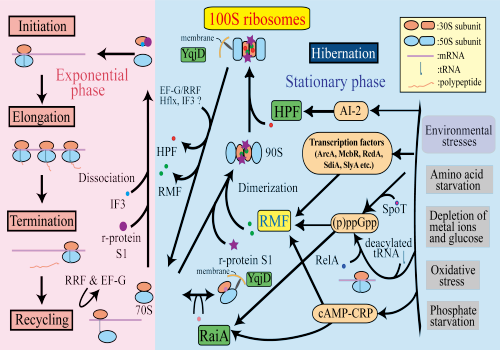RESEARCH
Elucidation of the mechanism of functional regulation of ribosomes, the protein synthesis machinery (Yoshida)
100S ribosome
Bacteria exposed to a variety of environments in nature have sophisticated adaptive systems. Under stress conditions such as nutrient starvation, temperature change, and osmotic alteration, cell growth is inhibited and many morphological and physiological changes occur, including cell shape and cell wall composition. As part of this adaptive system, it is known that protein factors called RMF and HPF bind to the 70S ribosome, the bacterial protein synthesis machinery, and inhibit protein synthesis activity. The inactive ribosome to which these protein factors bind is a dimer of the 70S ribosome and is called the 100S ribosome.
When the RMF or HPF genes are deleted, the bacteria are unable
to form 100S ribosomes, making long-term survival impossible. This indicates
that the mechanism to inhibit protein synthesis activity under stress is
an important survival strategy of bacteria. The state in which ribosomes
are inactivated is named "hibernation" and is incorporated into
the ribosome cycle (see figure below).
Currently, the formation pathway of the 100S ribosome and its
significance are being studied.

Exploring the principle of operation of ATP synthase (biomolecular motor) by single molecule observation (Furuike)
Here comes text. Here comes text. Here comes text. Here comes text. Here comes text. Here comes text. Here comes text. Here comes text. Here comes text. Here comes text. Here comes text. Here comes text. Here comes text. Here comes text.
Here comes text. Here comes text. Here comes text. Here comes text. Here comes text. Here comes text. Here comes text. Here comes text. Here comes text. Here comes text. Here comes text. Here comes text. Here comes text. Here comes text. Here comes text. Here comes text. Here comes text. Here comes text. Here comes text. Here comes text. Here comes text. Here comes text. Here comes text. Here comes text. Here comes text. Here comes text.
Investigation of the regulatory mechanism of bacterial gene expression in response to environment (Maki)
Here comes text. Here comes text. Here comes text. Here comes text. Here comes text. Here comes text. Here comes text. Here comes text. Here comes text. Here comes text. Here comes text. Here comes text. Here comes text. Here comes text.
Here comes text. Here comes text. Here comes text. Here comes text. Here comes text. Here comes text. Here comes text. Here comes text. Here comes text. Here comes text. Here comes text. Here comes text. Here comes text. Here comes text.